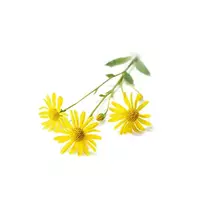Arnika mountain

Mountain arnica is a perennial herbaceous plant that is assigned to the Astrovs family. The so-called informal or folk names of the plant are more common. Arnika is called mountain lamb, Ivanov color or mountain tobacco, as well as forest cloves, litter or hare cabbage. Mountain arnica is referred primarily to medicinal plants. Dried flower petals and rhizome of mountain arnica are used in cooking.
The useful properties of the arnica have been known to mankind since ancient Greece. One of the luminaries of ancient Greek medicine, Dioscorides, described the appearance, methods of application and useful properties of the arnica in his works. Arnika grows throughout Europe, the Russian Federation, as well as in the countries of the post-Soviet space. Usually the plant chooses forest clearings, edges or meadows.
Arnica is a stalk no more than 15 cm long, with a numerous rhizome and leaves in the form of a wide rosette. The mountain arnica blooms in yellow flowers with small leaves elongated in shape. The fruits of the plant are dark and gray in color seeds with a fluffy crest of white at the base. Arnika is collected from the end of June to the first decade of July. Flowers and roots of mountain arnica are harvested in order to be used in medicine or as a spice.
Arnika composition
It is simply inappropriate to talk about the chemical composition of the arnica as a whole, since each part of the plant is enriched with different vitamins and biologically active elements. For example, plant rhizomes contain a large amount of tannins, resin and essential oil. Coloring substances that are contained in the arnica are used for the production of arnicine dye. In addition, arnica flowers contain essential oil, ascorbic acid, choline, carotenoids, gum, polysaccharide insulin and organic acids.
This chemical composition of the plant most eloquently indicates the unique benefits of mountain arnics for the human body. Often arnica is used as a means of traditional medicine, which has choleretic properties. The plant also helps in the prevention and treatment of diseases of the nervous system. The uniqueness of mountain arnica lies in the fact that the plant does not cause allergic reactions and is not able to harm human life or health.
In most cases, arnica is used in the production of alcoholic beverages, both at home and in industrial conditions. Arnica flowers are used to produce liqueurs and tinctures, which are often used as a medicine. Also, dried leaves of arnica flowers are added to meat and fish dishes as part of spicy mixtures. It is not unreasonably believed that frequent consumption of arnics helps strengthen immunity and protect a person from colds and viral diseases during the cold season.
mountain arnics 0.1 kKal
Energy value of mountain arnics (Ratio of proteins, fats, carbohydrates - ju):
Proteins: 0.1 g (~ 0 kCal)
Fats: 0.1 g (~ 1 kCal)
Carbohydrates: 0.1 g (~ 0 kCal)
Energy ratio (b | y): 400% | 900% | 400%
 Español
Español Français
Français Português
Português Русский
Русский 简体中文
简体中文 繁體中文
繁體中文 日本語
日本語 한국어
한국어 العربية
العربية Türkçe
Türkçe Қазақ
Қазақ Deutsch
Deutsch Italiano
Italiano Українська
Українська
